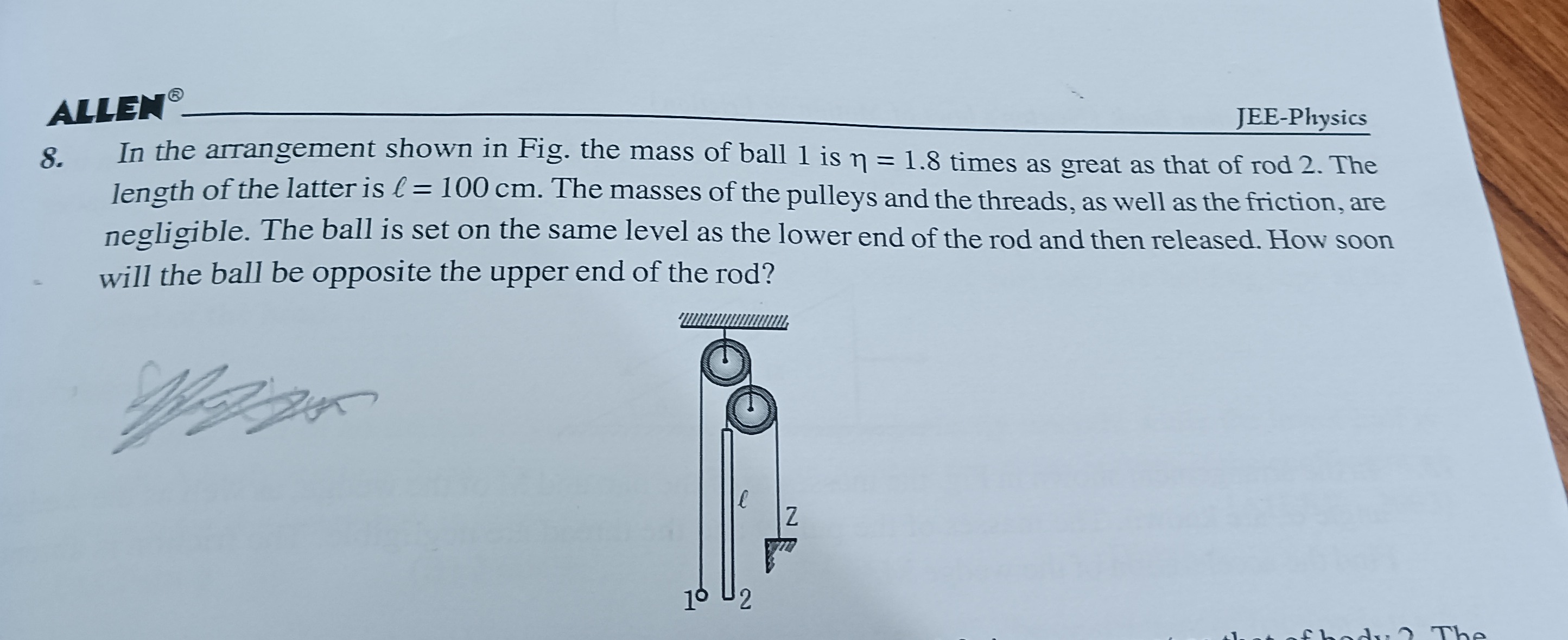Question
Question: In the arrangement shown in Fig. the mass of ball 1 is $\eta$ = 1.8 times as great as that of rod 2....
In the arrangement shown in Fig. the mass of ball 1 is η = 1.8 times as great as that of rod 2. The length of the latter is l = 100 cm. The masses of the pulleys and the threads, as well as the friction, are negligible. The ball is set on the same level as the lower end of the rod and then released. How soon will the ball be opposite the upper end of the rod?

0.698 s
Solution
Let m1 be the mass of the ball and m2 be the mass of the rod. We are given m1=ηm2, where η=1.8. The length of the rod is l=100 cm = 1 m. Let a1 be the downward acceleration of the ball and a2 be the downward acceleration of the rod. From the pulley system configuration, the velocity of the ball is twice the velocity of the movable pulley, and the movable pulley moves with the same velocity as the rod. Thus, the acceleration of the ball is twice the acceleration of the rod: a1=2a2.
Let T1 be the tension in the thread supporting the ball and T2 be the tension in the thread supporting the rod. Applying Newton's second law: For the ball: m1g−T1=m1a1 For the rod: m2g−T2=m2a2 For the massless movable pulley: 2T1−T2=0⟹T2=2T1.
Substitute T1=T2/2 into the equation for the ball: m1g−T2/2=m1a1 Substitute T2=m2g−m2a2 and a1=2a2: m1g−(m2g−m2a2)/2=m1(2a2) 2m1g−m2g+m2a2=4m1a2 2m1g−m2g=(4m1−m2)a2 a2=4m1−m22m1−m2g Substitute m1=ηm2: a2=4ηm2−m22ηm2−m2g=(4η−1)m2(2η−1)m2g=4η−12η−1g. With η=1.8: a2=4(1.8)−12(1.8)−1g=7.2−13.6−1g=6.22.6g=3113g.
Let the initial level of the ball and the lower end of the rod be the origin y=0. Downward is positive. Initial position of the ball: y1(0)=0. Initial position of the lower end of the rod: y2,lower(0)=0. Initial position of the upper end of the rod: y2,upper(0)=y2,lower(0)−l=0−l=−l.
The position of the ball at time t is y1(t)=y1(0)+v1(0)t+21a1t2=0+0+21a1t2=21a1t2. The position of the upper end of the rod at time t is y2,upper(t)=y2,upper(0)+v2(0)t+21a2t2=−l+0+21a2t2=−l+21a2t2.
The question asks for the time when the ball is opposite the upper end of the rod, which means their vertical positions are the same: y1(t)=y2,upper(t). 21a1t2=−l+21a2t2 21(a1−a2)t2=−l Substitute a1=2a2: 21(2a2−a2)t2=−l 21a2t2=−l. This equation gives a negative value for t2, which is not physically possible.
Let's reconsider the relative motion. The initial position of the upper end of the rod relative to the ball is y2,upper(0)−y1(0)=−l−0=−l. The relative acceleration of the upper end of the rod with respect to the ball is a2−a1=a2−2a2=−a2. The relative position at time t is y2,upper(t)−y1(t)=(y2,upper(0)−y1(0))+(v2,upper(0)−v1(0))t+21(a2−a1)t2. y2,upper(t)−y1(t)=−l+0⋅t+21(−a2)t2=−l−21a2t2. We want the time when y2,upper(t)−y1(t)=0. 0=−l−21a2t2. This still leads to l=−21a2t2.
Assuming that the intended question is "How soon will the upper end of the rod be at the initial level of the ball?", which is y=0. We set y2,upper(t)=0: −l+21a2t2=0 21a2t2=l t2=a22l t=a22l
Substitute a2=3113g and l=1 m: t=(13/31)g2×1=13g62 Using g=9.8m/s2: t=13×9.862=127.462≈0.486656≈0.6976 s. Rounding to three decimal places, t≈0.698 s.
The final answer is 0.698.
Explanation of the solution: Let m1 be the mass of the ball and m2 be the mass of the rod. m1=ηm2=1.8m2. Let l be the length of the rod. Analyzing the pulley system, the downward acceleration of the ball a1 is twice the downward acceleration of the rod a2, i.e., a1=2a2. Using Newton's second law for the ball and the rod, and considering the tensions in the threads (T2=2T1), we find the acceleration of the rod: a2=4m1−m22m1−m2g=4η−12η−1g. Substitute η=1.8: a2=4(1.8)−12(1.8)−1g=7.2−13.6−1g=6.22.6g=3113g. Let the initial level of the ball and the lower end of the rod be the origin y=0. Downward is positive. Initial position of ball: y1(0)=0. Initial position of upper end of rod: y2u(0)=−l. Position at time t: y1(t)=21a1t2, y2u(t)=−l+21a2t2. Assuming the question asks for the time when the upper end of the rod reaches the initial level of the ball, we set y2u(t)=0. −l+21a2t2=0. 21a2t2=l. t2=a22l. t=a22l. Substitute a2=3113g and l=1 m: t=(13/31)g2×1=13g62. Using g=9.8m/s2: t=13×9.862=127.462≈0.486656≈0.6976 s.
The final answer is ≈0.698 s.
